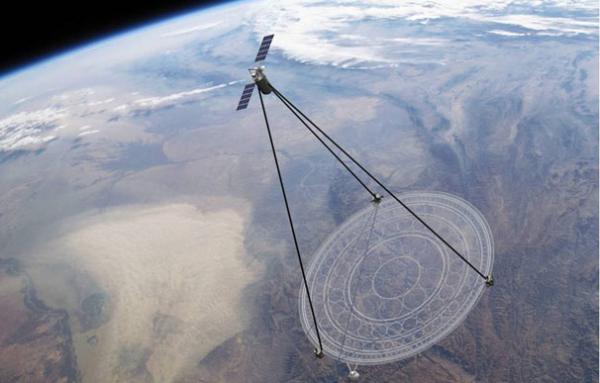'Dream' Space Telescope for Military Could Spy Anywhere on Earth

If the U.S. military wants live video of a missile launcher vehicle halfway around the world, it must rely upon spy planes or drones in danger of being shot down. Tomorrow, the Pentagon wants space telescopes hovering in geosynchronous orbit that could take real-time images or live video of any spot on Earth.
Contrary to Hollywood's ideas, today's spy satellites that orbit the Earth at fast speeds and relatively lower altitudes can only snap photos for the U.S. military and intelligence agencies. Taking live video of a single location would require satellites to hover by matching the Earth's rotation in geosynchronous orbit about 22,000 miles (36,000 kilometers) high — but creating and launching a space telescope with the huge optics arrays capable of seeing ground details from such high orbit has proven difficult.
As a solution, DARPA — the Pentagon's research arm — envisions a lightweight optics array made of flexible membrane that could deploy in space. Ball Aerospace has just completed an early proof-of-concept review as part of a DARPA contract worth almost $37 million.
"The use of membrane optics is an unprecedented approach to building large aperture telescopes," said David Taylor, president and chief executive officer of Ball Aerospace in Boulder, Colo.
DARPA eventually wants a space telescope with a collection aperture (light-collecting power) of almost 66 feet (20 meters) in diameter. By comparison, NASA's next-generation James Webb Space Telescope is designed to have an aperture of just 21 feet (6.5 m).
Such a telescope should be able to spot missile launcher vehicles moving at speeds of up to 60 mph on the ground, according to the DARPA contract. That would also require the image resolution to see objects less than 10 feet (3 m) long within a single image pixel.
But first, Ball Aerospace must create and test a 16-foot (5 m) telescope in the DARPA project's second phase. Phase three would involve launching a 32-foot (10 m) telescope for flight tests in orbit.
Breaking space news, the latest updates on rocket launches, skywatching events and more!
If all goes well, U.S. military commanders and intelligence agents may someday get live streaming video and up-to-date images of battlefields or trouble spots around the world. Such capability could complement the swarms of cheap drones providing battlefield surveillance today, and might even spare the U.S. embarrassment from losing spy drones over Iran or other countries.
NASA may also want a similarly flexible solution for cheaper space telescopes — except aimed away from Earth rather than spying on this blue marble of a planet.
This story was provided by InnovationNewsDaily, a sister site to SPACE.com. Follow InnovationNewsDaily on Twitter @News_Innovation, or on Facebook.

Space.com is the premier source of space exploration, innovation and astronomy news, chronicling (and celebrating) humanity's ongoing expansion across the final frontier. Originally founded in 1999, Space.com is, and always has been, the passion of writers and editors who are space fans and also trained journalists. Our current news team consists of Editor-in-Chief Tariq Malik; Editor Hanneke Weitering, Senior Space Writer Mike Wall; Senior Writer Meghan Bartels; Senior Writer Chelsea Gohd, Senior Writer Tereza Pultarova and Staff Writer Alexander Cox, focusing on e-commerce. Senior Producer Steve Spaleta oversees our space videos, with Diana Whitcroft as our Social Media Editor.

